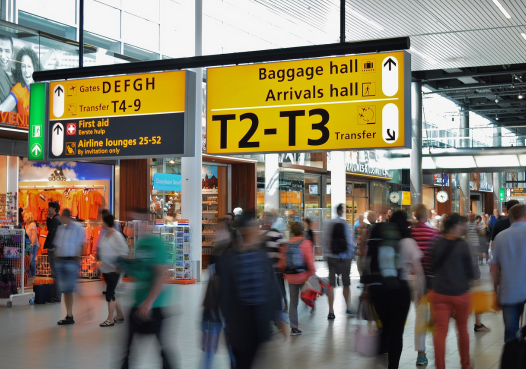Europe’s airports post two year high in recovering air passenger traffic

Brussels, 5 May 2022: European airport trade body, ACI EUROPE, today released its airport traffic report for March 2022 and full Quarter 1 2022.
Note: Unless otherwise specified, all data reported below are against pre-pandemic (2019) corresponding reporting periods.
The report confirms the recovery in passenger traffic, with March seeing the European airport network posting its best monthly performance so far since the start of the COVID-19 pandemic, at -34.1% (Q1 stands at -39.6%).
EU+ MARKET SURGES FORWARD
This March recovery was the result of most States in the EU+ area finally easing restrictions for both intra-European and external travel on the back of strong pent-up demand. Accordingly, passenger traffic at airports across the area stood at -34.3% in March, up from –51.1% in January (Q1 as a whole stood at -42.1%).
The best performing markets in the EU+ area in March were Portugal (-16.3%), Romania (-21.8%) and Spain (-21.9%). Worst performing were Slovenia (-61.9%), Slovakia (-58%) and Germany (-51.7%). Airports in the UK (-38.2%) finally came closer to the EU+ area average while those in France (-29.5%) outperformed it.
REST OF EUROPE FIGURE IMPACTED BY WAR
In the rest of Europe, the Russian war against Ukraine resulted in passenger traffic significantly deteriorating in March to -32.9%, down from -23.8% in January (Q1 at -26.5%).
The slump in March came from the loss of all passenger traffic at Ukrainian airports and of most passenger traffic at Moldavian airports (-94.5%), as well as reduced passenger traffic at Russian airports. The latter resulted primarily from the EU and UK air traffic bans, but also from the closure by the Russian Government of more than 10 commercial airports in the Southern part of that country. While passenger traffic at Russian airports had recovered their pre-pandemic volumes at the start of the year, it went down by an estimated average of -24% in March at those Russian airports remaining in operation.
Elsewhere in the non-EU+ area, while passenger traffic also deteriorated at Georgian airports (-38%), it kept improving in all other markets including in Serbia (-21%) and Turkey (-24.5%). Airports in Armenia (+0.4%) achieved a full recovery, while those in Albania (+38.9%) and Kosovo (+15.1%) were way above their pre-pandemic volumes.
Olivier Jankovec, Director General of ACI EUROPE said: “The impact of the war staged by Russia in Ukraine on passenger traffic has been contained to these countries and a few others in their immediate vicinity. For airports in the rest of Europe, the easing of COVID-19 travel restrictions not just on the continent but also increasingly for intercontinental travel bodes very well for the Summer season.
The immediate challenge is to manage the sudden surge in traffic given that the pandemic left airports and ground handlers with hugely depleted resources. This now requires re-staffing in what is a very tight labour market across Europe. What’s more, the time required by national security clearance procedures for airport staff combined with training requirements simply make it impossible to adjust overnight. All this, combined with traffic being much more concentrated over peak periods, is putting significant strain on the entire aviation system as we strive to recover.”
MAJORS NOW IMPROVING FASTER
The Majors (Top 5 European airports) saw passenger traffic improving significantly at -34.5% in March, up from -48.5% in January.
Istanbul (-20%) remained the busiest European airport, but London-Heathrow (-35.7%) jumped to the 2nd position up from the 4th over the preceding month - followed by Paris-CDG (-35.2%), Amsterdam-Schiphol (-33.8%) and Madrid-Barajas Adolfo Suarez (-27.5%).
SMALLER & REGIONAL AIRPORTS STILL AHEAD
At smaller & regional airports, passenger traffic stood at -24.9% in March, up from -38% January, with an average of -32.1% for Q1.
Low Cost airlines’ strongholds such as Milan-Bergamo (-5.7%), Charleroi (-5.2%) and Kaunas (-7.2%) came close to achieving a full recovery in March.
Insular airports serving popular tourism destinations also came at or close to full recovery in March: Paphos (+1.4%), Palermo (+0.6%), Ibiza (-2.1%), Chania (-2.5%), Funchal (-4%), Catania (-7.5%), Ajaccio (-9.1%) and Lanzarote (-9.2%).
FREIGHT & MOVEMENTS
Freight traffic across the European airport network stood at +4.9% in March and at +5.1% for Q1. Freight traffic kept progressing in the EU+ bloc (+5.7%) but deteriorated in the rest of Europe (-2.6%) in March – a direct result of the war in Ukraine.
Aircraft movements across the European airport network were at -27.7% in March, up from -42.1% in January. They stood at -31.5% for Q1.
During March, airports welcoming more than 25 million passengers per year (Group 1), airports welcoming between 10 and 25 million passengers (Group 2), airports welcoming between 5 and 10 million passengers (Group 3) and airports welcoming less than 5 million passengers per year (Group 4) reported an average decline of -37.4%, -34.0%, -22.9% and -24.9% respectively.

